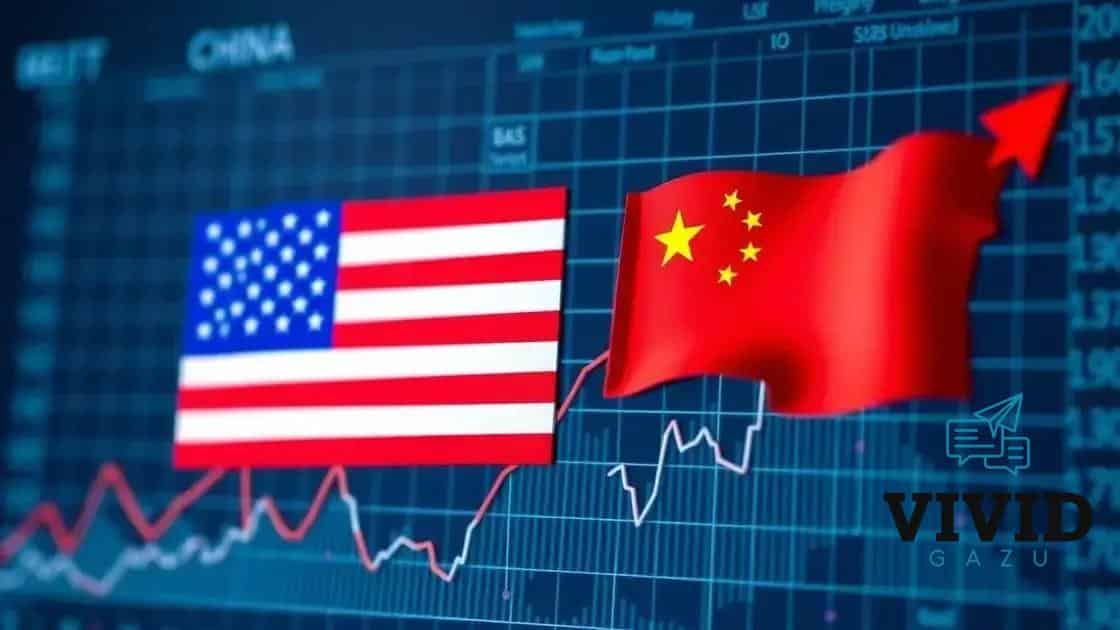Financial repercussions of the US-China trade conflict

The financial repercussions of the US-China trade conflict include increased market volatility, disruptions in supply chains, and shifts in consumer behavior, necessitating strategic adaptations for businesses globally.
Financial repercussions of the US-China trade conflict are reverberating across the globe. Have you noticed how this situation influences markets and everyday prices? Let’s dive into this complex topic.
Overview of the US-China trade conflict
The US-China trade conflict is a significant topic that affects economies worldwide. Understanding its roots helps grasp its implications. This conflict began to escalate in 2018 and has involved multiple rounds of tariffs and negotiations.
Background of the conflict
Initially, the trade imbalance between the two countries sparked tension. The United States imported much more from China than it exported. Thus, voices advocating for action started rising. One approach was the imposition of tariffs.
Key events leading to the conflict
Several important measures have ignited the conflict:
- Tariffs on steel and aluminum
- China’s retaliation with tariffs on US goods
- Intellectual property theft accusations
- Attempts at trade negotiations
The situation has created uncertainty for businesses and consumers alike. Economies are closely monitoring these events.
Current status
As of now, both countries remain heavily engaged in dialogues. However, tensions continue to exist due to differing priorities and economic strategies. The impact on global markets is notable, with many countries watching the developments.
In conclusion, the US-China trade conflict is not just a bilateral issue. It is a theme with ramifications that extend far beyond borders, impacting economies globally.
Key financial impacts on global markets

The financial impacts of the US-China trade conflict extend beyond just these two nations. Global markets feel the pressure as economic ties shift and adapt. Understanding these impacts is crucial for businesses and investors.
Market volatility
One significant effect has been increased market volatility. Investors react to news and policies, leading to rapid changes in stock prices. This uncertainty can create challenges for companies planning their budgets and investments.
Changes in commodity prices
The trade conflict has also affected commodity prices worldwide. For instance, tariffs on steel and aluminum have led to increased costs for manufacturers. This rise is often passed down to consumers, affecting everything from cars to household goods.
- Higher production costs for manufacturers
- Increased prices for consumers
- Shifts in demand for certain products
- Impact on global supply chains
Additionally, these changes in commodity prices have widespread effects. Countries that rely on exports to the US and China may experience economic shifts as demand fluctuates. This uncertainty pushes many businesses to rethink their strategies.
Currency exchange fluctuations
As tensions continue, currency exchange rates also experience fluctuations. For instance, the value of the yuan and US dollar can change rapidly based on trade announcements. These shifts impact international trade agreements and can alter profit margins for businesses.
Understanding these financial impacts is essential for navigating the current economic landscape. Because changes can happen quickly, staying informed allows businesses to adapt to new challenges and seize opportunities.
Effects on supply chains and production
The US-China trade conflict heavily influences supply chains and production methods worldwide. Many companies are feeling the pinch, as they depend on both nations for raw materials, parts, and finished goods.
Disruptions in supply chains
One major effect of the conflict is disruption in supply chains. When tariffs are imposed, companies often face increased costs. This situation can lead to delays in delivering products to consumers.
Rethinking production locations
As trade tensions rise, many businesses are reconsidering where they produce their goods. Some have started moving production out of China to avoid tariffs.
- Shifting to countries like Vietnam or India
- Exploring automation to reduce reliance on labor
- Diversifying suppliers to minimize risks
- Increasing investments in domestic production
This shift affects not just manufacturers, but also logistics firms that transport goods. They must keep up with new routes and regulations, which can add complexity to their operations.
Impact on pricing and consumer choices
As companies adjust to these supply chain challenges, consumers may notice changes in pricing and availability of products. For example, if a company moves its production overseas, it might raise prices to cover new costs. Consumers may also find fewer choices on shelves as companies streamline their offerings.
In summary, the effects on supply chains and production are vast and impactful. Businesses are adapting daily, finding new ways to cope with shifting demands and pressures from the ongoing conflict.
Response strategies for businesses
In the face of the ongoing US-China trade conflict, businesses are seeking effective response strategies. The need to adapt is crucial for survival in a changing economic landscape.
Adapting supply chains
One effective strategy is to adapt supply chains. Companies can reduce risks by diversifying their suppliers across various regions. This helps mitigate the impact of tariffs and unpredicted trade changes.
Increasing efficiency
Businesses should also focus on increasing efficiency. Investing in technology and automation can streamline processes and reduce costs. This approach allows companies to remain competitive, even when faced with rising prices.
- Implementing new software solutions
- Optimizing logistics and inventory management
- Conducting regular efficiency audits
- Training staff on new technologies
Furthermore, many companies are re-evaluating their pricing strategies. By carefully analyzing their pricing structures, they can find ways to maintain margins without losing customers. This careful approach is essential in such a fluctuating market.
Building strong relationships
Another significant strategy is to build strong relationships with partners and customers. Open communication increases trust and can lead to better deals with suppliers and loyal customers who understand pricing changes.
In today’s environment, the ability to respond swiftly and effectively is critical. By employing various strategies, businesses can navigate the challenges presented by the US-China trade conflict successfully.
Future outlook and trends
The future outlook of the US-China trade conflict remains uncertain, but several trends are emerging. As businesses and governments respond to changes, it is crucial to watch how these developments will unfold.
Innovation and technology
One key trend is the push for innovation and technology adoption. Companies are increasingly investing in advanced technologies to improve efficiency and reduce dependency on traditional supply chains. Automation and artificial intelligence are becoming vital in this evolving landscape.
Regional supply chain shifts
Another trend is the regional shift in supply chains. More businesses are exploring alternatives to China for manufacturing, such as countries in Southeast Asia and India. This shift aims to mitigate risks associated with tariffs, trade barriers, and geopolitical tensions.
- Increased focus on local production
- Exploration of new trade partnerships
- Investment in logistics infrastructure
- Enhancing trade agreements with other countries
Countries are also reevaluating their trade policies as they seek to protect their economic interests. This includes discussions about reforming trade agreements and implementing tariffs. Such measures could further reshape global trade dynamics.
Consumer behavior changes
As the conflict continues, consumer behaviors may change as well. Shoppers might become more conscious of where their products come from. They could prefer goods made domestically or in countries with favorable trade relations. This pattern can drive companies to be more transparent about their sourcing practices.
Overall, the future outlook for the US-China trade conflict will likely involve ongoing changes and adaptations. Monitoring these trends is essential for businesses and investors looking to stay ahead in the competitive market.
FAQ – Frequently Asked Questions about the US-China Trade Conflict and Global Impact
What is the US-China trade conflict?
The US-China trade conflict refers to ongoing economic tensions between the two countries that began with tariff increases and have involved various rounds of trade negotiations.
How does the trade conflict impact global markets?
The conflict leads to increased market volatility, disruptions in supply chains, and changes in commodity prices, affecting businesses and consumers worldwide.
What strategies can businesses use to respond to the conflict?
Businesses can adapt by diversifying suppliers, increasing efficiency through technology, and building strong relationships with partners and customers.
What are the future trends related to the trade conflict?
Future trends include a focus on innovation, shifts in regional supply chains, and changes in consumer behaviors towards domestic products.





